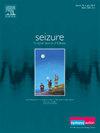A new developmental and epileptic encephalopathy: PUM1-neurodevelopmental disorder with epilepsy with myoclonic-atonic seizures
IF 2.8
3区 医学
Q2 CLINICAL NEUROLOGY
引用次数: 0
Abstract
Objective
Pathogenic variants in the PUM1 gene are linked to late-onset spinocerebellar ataxia and to a neurodevelopmental disorder (PUM1-associated developmental disability, ataxia, and seizures). The latter is very rare and encompasses developmental delay, intellectual disability, ataxia, seizures, and dysmorphic features with structural brain anomalies. This report introduces a novel presentation of a PUM1-related phenotype, characterized by epilepsy with myoclonic-atonic seizures (EMAtS) as the predominant feature, evolving without ataxia.
Methods
Through trio-based whole exome sequencing (WES), we identified a novel de novo heterozygous frameshift variant in the PUM1 gene. We reviewed all medical charts of the present patient, assessed his development and reviewed all previously reported cases with pathogenic variant of PUM1.
Results
A 3.5-year-old boy presented with epilepsy with myoclonic-atonic seizures (EMAtS), mild speech delay, mild dysmorphic features and no motor impairments. WES showed a de novo heterozygous frameshift pathogenic variant in PUM1 (NM_001020658:c.1159delC; p.Leu387Cysfs*13) NM_001020658.2(PUM1):c.1159delC (p.Leu387Cysfs*13. Treatment with antiseizure medication and dietary intervention led seizure control within one year, enabling developmental gains despite persisting delays in adaptive functioning and communication. A hallmark of this cases – ataxia – was not observed after epilepsy remission.
Conclusion
This case highlights the variability in PUM1-related phenotypes and underscores the importance of considering PUM1 pathogenic variants in early-onset generalized epilepsy, even in the absence of hallmark systemic features. It expands the phenotypic spectrum of PUM1-associated disorders by describing a unique childhood-onset epilepsy presentation, emphasizing the variability in clinical manifestations and the potential for favorable outcomes with appropriate management.
一种新的发育性和癫痫性脑病:pum1 -神经发育障碍伴癫痫并肌阵挛性失张力发作
目的:PUM1基因的致病性变异与迟发性脊髓小脑共济失调和神经发育障碍(PUM1相关的发育障碍、共济失调和癫痫发作)有关。后者非常罕见,包括发育迟缓、智力残疾、共济失调、癫痫发作和畸形特征,伴有结构性脑异常。本报告介绍了一种新的pum1相关表型,其特征是癫痫伴肌阵挛性无张力发作(EMAtS)为主要特征,发展无共济失调。方法通过三基全外显子组测序(WES),我们在PUM1基因中发现了一个新的从头杂合移码变异。我们回顾了本例患者的所有病历,评估了他的病情发展,并回顾了所有先前报道的PUM1致病性变异病例。结果1例35岁男孩,癫痫伴肌强直性发作(EMAtS),轻度言语迟缓,轻度畸形,无运动障碍。WES在PUM1中发现了一个全新的杂合移码致病变异(NM_001020658:c.1159delC;p.Leu387Cysfs * 13) NM_001020658.2 (PUM1): c。1159年delc (p.Leu387Cysfs * 13。抗癫痫药物治疗和饮食干预导致癫痫发作在一年内得到控制,尽管在适应功能和沟通方面持续存在延迟,但仍取得了发展进展。这种情况的标志-共济失调-没有观察到癫痫缓解后。结论:本病例强调了PUM1相关表型的可变性,并强调了在早发性全身性癫痫中考虑PUM1致病变异的重要性,即使在没有标志性的全身特征的情况下。它通过描述一种独特的儿童期癫痫表现,扩大了pum1相关疾病的表型谱,强调了临床表现的可变性,以及通过适当的治疗可能产生的良好结果。
本文章由计算机程序翻译,如有差异,请以英文原文为准。
求助全文
约1分钟内获得全文
求助全文
来源期刊

Seizure-European Journal of Epilepsy
医学-临床神经学
CiteScore
5.60
自引率
6.70%
发文量
231
审稿时长
34 days
期刊介绍:
Seizure - European Journal of Epilepsy is an international journal owned by Epilepsy Action (the largest member led epilepsy organisation in the UK). It provides a forum for papers on all topics related to epilepsy and seizure disorders.
 求助内容:
求助内容: 应助结果提醒方式:
应助结果提醒方式:


